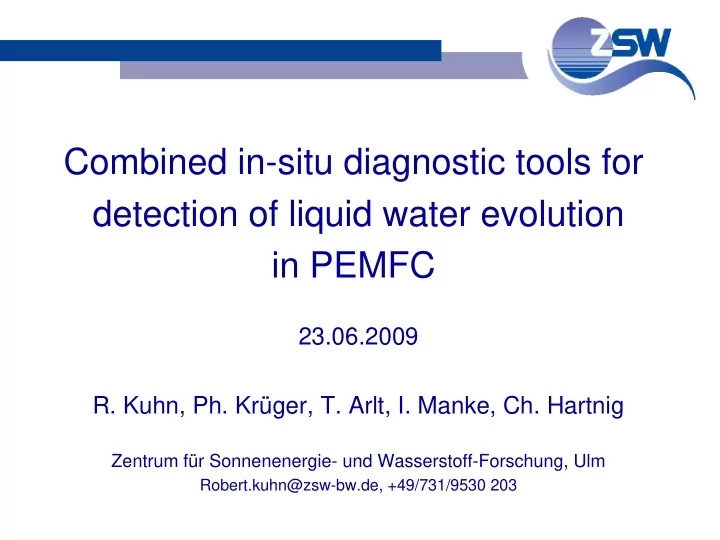

Combined in-situ diagnostic tools for detection of liquid water evolution in PEMFC 23.06.2009 R. Kuhn, Ph. Krüger, T. Arlt, I. Manke, Ch. Hartnig Zentrum für Sonnenenergie- und Wasserstoff-Forschung, Ulm Robert.kuhn@zsw-bw.de, +49/731/9530 203 - 1 -
- 2 -
water distribution in fuel cells two main factors influence the distribution and the balance between anode and cathode: - electro-osmotic drag (protonic current) - back diffusion (liquid water gradient) protonic current electro-osmotic drag anode cathode back diffusion liquid water gradient - 3 -
presented methods for fuel cell research synchrotron neutron neutron radiography tomography radiography spatial resolution 80 μ m 200 μ m 3 μ m - 4 -
comparison between X-rays and neutrons X-rays photo electron X-rays (100 keV) X-rays (100 keV) absorption 2 /g) 2 /g) Thermal neutrons core Mass attenuation coefficient, (cm Mass attenuation coefficient, (cm 2 2 10 10 scattering neutrons 0 0 10 10 core absorption -2 -2 10 10 0 20 40 60 80 100 0 20 40 60 80 100 scattering Atomic number Atomic number - 5 -
why neutrons? X-rays (100 keV) 2 /g) Thermal neutrons Mass attenuation coefficient, (cm 10 B Gd 113 Cd light 1 H 2 elements 10 Li heavy metals elements 0 Co 10 Au Ni Fe Pb Al -2 10 0 20 40 60 80 100 Atomic number - 6 -
radiography neutron - 7 -
neutron tomography and radiography 30 cm – 2 cm sample size 200 µm – 80 µm resolution 0.1 µm 1 m 1 cm 1 µm 0.1 mm - 8 -
neutrons can ‘see’ water in fuel cells normalization of images: water distribution map original radiography water distribution ratio: water filled cell /empty cell 100 mm - 9 -
neutrons can ‘see’ water in fuel cells evolution of liquid water on anode side Air out H2 in 50 mm H2 out Air in 100 mm 8 mm - 10 -
neutrons can ‘see’ water in fuel cells single cell water distribution 200 mA/cm2, 60% u.C, 20% u.A mask for anode channel cathode outlet 100% r. H. , anode inlet 0% r. H. H2 in Air out H2 out Air in - 11 -
neutrons can ‘see’ water in fuel cells evaporation of liquid water in a channel 200 mA/cm2, 60% u.C, 20% u.A cathode outlet 100% r. H. , anode inlet 0% r. H. 38 min real time time scanline - 12 -
neutrons can ‘see’ water in fuel cells single cell water distribution 500 mA/cm2, 60% u.C, 20% u.A mask for anode chanel cathode outlet 100% r. H. , H2 in Air out anode inlet 0% r. H. H2 out Air in - 13 -
tomography neutron - 14 -
neutron tomography anode H 2 out H 2 in cathode air out air in - 15 -
tomography neutron - 16 -
neutron tomography: triple stack cell 1 cell 2 cell 3 Water amount • separate analysis of cells in a multi-stack • differentiation between anode and cathode - 17 -
synchrotron radiography - 18 -
synchrotron radiography 1 cm – 0.3 mm sample size 7 µm – 0.3 µm resolution 0.1 µm 1 m 1 cm 1 µm 0.1 mm - 19 -
high resolution in-situ synchrotron radiography neutron radiography in-situ synchrotron radiography A C 100 mm normalization 7 mm 100 times higher spatial resolution + 1000 times higher water sensitivity compared to neutron-based methods [I. Manke, Ch. Hartnig et al. Applied Physics Letters 90, 174105 (2007)] - 20 -
through plane view integral imaging: summarized presentation of the cathodic and anodic channels and gas diffusion media - 21 -
time dependence of liquid water evolution close look at three different spots: 1: in the channel 2: under the rib (next to point #1) 3: under the rib, no periodic pumping observed anodic gas channels A C C C cathodic A gas channels time dependence of the ‘filling degree’ - 22 -
dynamics of liquid water evolution (time lapse movie) - 23 -
time dependence of liquid water evolution 1 2 • strong correlation of water content of the two adjacent positions in the channel and under the rib transport pathway • continous filling of the GDL + eruptive emptying of the pores - 24 -
cross sectional view uncorrected image after normalization with respect to an ‘empty cell’ components [Ch. Hartnig, I. Manke et. al, APL 92 (2008) 134106] - 25 -
cross sectional insights differentiation between MPL and GDL (substrate) small water clusters in the nano-litre range detectable - 26 -
depth profile of water distribution MPL quantification and differentiation of separate areas possible formation of water clusters next to the MPL (temperature difference) formation of a second diffusion barrier from i 0 > 400 mA/cm 2 onwards - 27 -
augmented reality proposed model for liquid water transport: liquid water collects under the lands of the flow fields and is transferred to the channel in an eruptive mechanism two different contributions: - liquid water can evaporate and diffuse as vapour through the GDL - liquid water collects in the GDL and erupts to the channel - 28 -
conclusion / lessons learned neutron radiography: - determination of wet/dry cell regions - evolution of water cluster on the anode side - over all cell effects of flooding and opening of channels neutron tomography: - 3D distribution of liquid water in fuel cell stacks - layer-by-layer determination of water distribution: synchrotron radiography: - initial formation of liquid water under the lands of the flowfield on the cathode side - visualization of micro structure transport pathways - 29 -
acknowledgements team at HZB: Nikolay Kardjilov André Hilger team at ZSW: Ludwig Jörissen Joachim Scholta Frank Häussler RuNPEM-partners DFG (Le 1433/1-2) BMBF (03SF0324) thank you for your attention! - 30 -
Recommend
More recommend